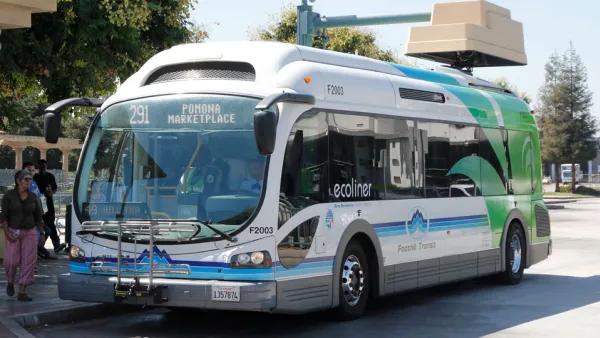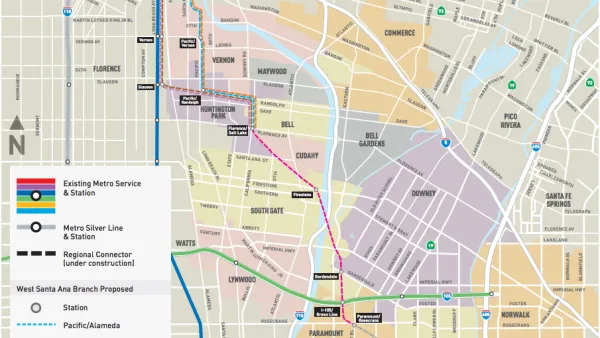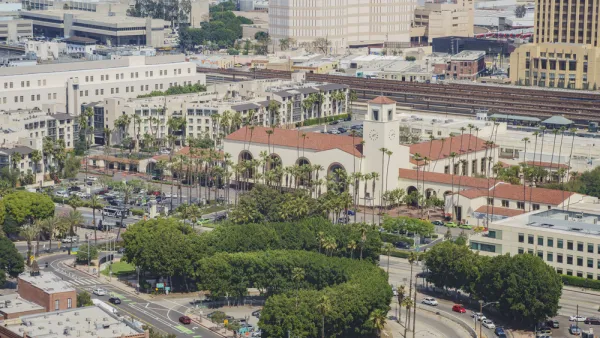Unprecedented transit build-out in California could transform the state. Now leaders are working to ensure the infrastructure connecting major cities also benefits the communities it touches along the way.
The leaders of California's High Speed Rail project and Los Angeles County Metro shared strategies for meeting this challenge at ULI's Transit Oriented Los Angeles.
In Los Angeles, Metro is trying out new methods to ease the hardship of construction periods that disrupt street-level activity. Its more direct approaches include a Business Interruption Fund, which compensates businesses impacted by construction, and a Business Solutions Center, which offers special guidance to small businesses.
In this new wave of expansion, the agency is also embracing a broader guiding principle known as "transit-oriented communities," which widens the scope of transit-oriented development planning to the field of entire neighborhoods.
But high-speed rail will pass through a number of rural areas in the middle of the state that don’t have the level of resources, existing transportation infrastructure, or market activity accessible in Los Angeles County. Historically, the Central Valley region has been shut out of investments in transportation that went not "through it," but "past it" on its way to metropolitan areas in the north and the south.
Not so for CAHSRA, CEO Jeff Morales says. Through local-hire programs and small business partnerships, the Authority is determined to bring one of the poorest regions in the country into the fold: "We’re transitioning from looking at high-speed rail as something to get people from San Francisco to LA and instead seeing it as tying together the state and reinforcing what’s happening in our cities."
Both agencies are collaborating to integrate the new infrastructure required by HSR into the county’s ongoing rail expansion plans, creating opportunities to prepare the growing city for the transit patterns of the future. "We have to think about not what LA is today, but what it’s going to be," Morales urged the audience.
The conversation was moderated by Planning Report publisher David Abel and reprinted in The Planning Report. It also covers Metro’s potential half-cent sales tax, and the Gold Line extension opening March 5.
FULL STORY: LA Metro & CAHSRA Collaborate on Aligning Community and Transportation Investment

Analysis: Cybertruck Fatality Rate Far Exceeds That of Ford Pinto
The Tesla Cybertruck was recalled seven times last year.

National Parks Layoffs Will Cause Communities to Lose Billions
Thousands of essential park workers were laid off this week, just before the busy spring break season.

Retro-silient?: America’s First “Eco-burb,” The Woodlands Turns 50
A master-planned community north of Houston offers lessons on green infrastructure and resilient design, but falls short of its founder’s lofty affordability and walkability goals.

Test News Post 1
This is a summary

Analysis: Cybertruck Fatality Rate Far Exceeds That of Ford Pinto
The Tesla Cybertruck was recalled seven times last year.

Test News Headline 46
Test for the image on the front page.
Urban Design for Planners 1: Software Tools
This six-course series explores essential urban design concepts using open source software and equips planners with the tools they need to participate fully in the urban design process.
Planning for Universal Design
Learn the tools for implementing Universal Design in planning regulations.
EMC Planning Group, Inc.
Planetizen
Planetizen
Mpact (formerly Rail~Volution)
Great Falls Development Authority, Inc.
HUDs Office of Policy Development and Research
NYU Wagner Graduate School of Public Service




























